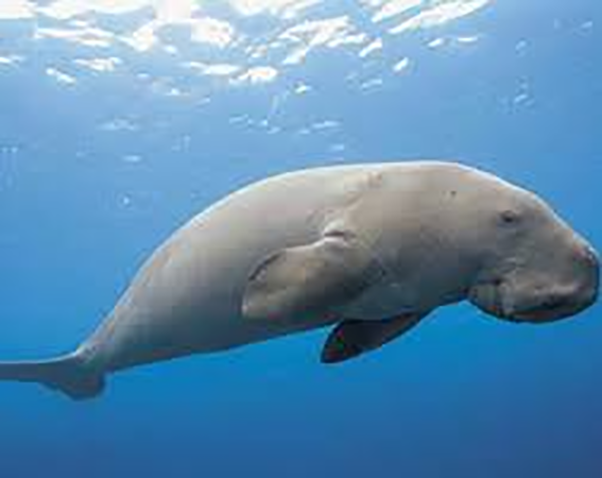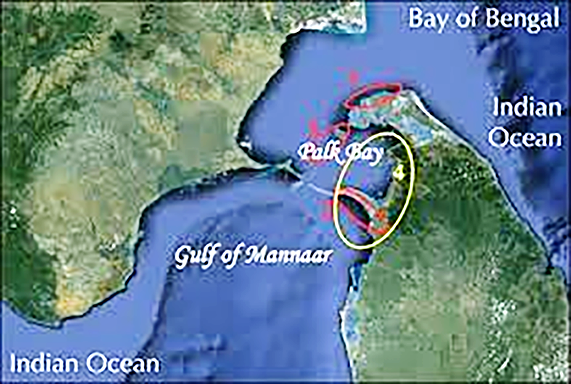Important Facts For Prelims
Dugong Conservation Reserve in Palk Bay
- 03 Mar 2022
- 4 min read
Why in News?
Recently, the Tamil Nadu government has decided to go ahead with the establishment of India's first conservation reserve for the Dugong in Gulf of Mannar, Palk Bay.
- It facilitates India to act as the leading nation in the South Asia Sub-region with respect to dugong conservation.
What are Dugongs?
- About:
- Dugong (Dugong dugon) also called ‘Sea Cow’ is one of the four surviving species in the Order Sirenia and it is the only existing species of herbivorous mammal that lives exclusively in the sea including in India.
- Dugongs are an important part of the marine ecosystem and their depletion will have effects all the way up the food chain.
- Distribution and Habitat: They are found in over 30 countries and in India are seen in the Gulf of Mannar, Gulf of Kutch, Palk Bay, and the Andaman and Nicobar Islands.
- Conservation Status:
- IUCN Red List status: Vulnerable
- Wild (Life) Protection Act, 1972: Schedule I
- CITES: Appendix I
- Threats:
- Dugongs graze on seagrass and the loss of seagrass beds due to ocean floor trawling is one of the most important factors behind decreasing dugong populations in many parts of the world.
- Trawling is a method of fishing that involves pulling a fishing net through the water behind one or more boats.
- It is harmful to the environment because it damages the seafloor, coral reefs and other marine animals.
- Human activities such as the destruction and modification of habitat, pollution, rampant illegal fishing activities, vessel strikes, unsustainable hunting or poaching and unplanned tourism are the main threats to dugongs.
- Dugong meat is consumed under the wrong impression that it cools down human body temperature.
- Dugongs graze on seagrass and the loss of seagrass beds due to ocean floor trawling is one of the most important factors behind decreasing dugong populations in many parts of the world.
- Steps Taken for Conservation:
- In February 2020, India hosted the 13th Conference of Parties (CoP) of the Convention on the Conservation of Migratory Species of Wild Animals (CMS), an environmental treaty under the aegis of the United Nations Environment Programme (UNEP).
- The Government of India has been a signatory to the CMS since 1983.
- India has signed non-legally binding Memorandums of Understanding (MoU) with CMS on the conservation and management of Siberian Cranes (1998), Marine Turtles (2007), Dugongs (2008) and Raptors (2016).
- The Ministry of Environment, Forests and Climate Change constituted a ‘Task Force for Conservation of Dugongs’ to look into issues related to conservation of dugongs and implementation of the ‘UNEP/CMS Dugong MoU’ in India.
- It also facilitates India to act as the leading nation in the South Asia Sub-region with respect to dugong conservation.
- In February 2020, India hosted the 13th Conference of Parties (CoP) of the Convention on the Conservation of Migratory Species of Wild Animals (CMS), an environmental treaty under the aegis of the United Nations Environment Programme (UNEP).
What are Conservation Reserves?
- Conservation reserves and community reserves are terms denoting protected areas of the country which typically act as buffer zones to or connectors and migration corridors between established national parks, wildlife sanctuaries and reserved and protected forests.
- Such areas are designated as conservation areas if they are uninhabited and completely owned by the Government of India but used for subsistence by communities and community areas if part of the lands are privately owned.
- These protected area categories were first introduced in the Wildlife (Protection) Amendment Act of 2002 − the amendment to the Wildlife Protection Act of 1972.
- These categories were added because of reduced protection in and around existing or proposed protected areas due to private ownership of land and land use.






